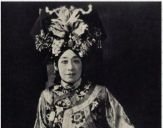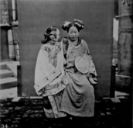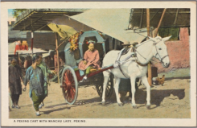Inventing the tradition
The arrival of the Manchus in the early 17th century brought many changes to Chinese society. To a certain extent there was a clash of cultures between the Manchus and the Han Chinese. One of the fronts on which this battle was fought was the female feet. The Han Chinese practice of foot binding was despised by the Manchus. Though foot binding continued to be practiced by Han Chinese during the Qing dynasty, Manchu women were strictly forbidden from doing so.[Cf, p 28-9] This was a distinct cultural difference.
Manchu and Han Chinese culture became more and more intertwined through the ages. The boundaries between them began to diminish. For Empress Dowager Cixi this was a major problem. By the end of the 19th century, Cixi started to promote the liangbatou as a typical Manchu headdress. Cixi was very proud of Manchu culture and one of the ways the Manchu identity had to be upheld was by wearing the Manchu liangbatou, as described by lady-in-waiting Der Ling:
She also talked about our headdress, and ordered some made the same as worn by the other Court ladies. She said to me: "I know you can wear my shoes, for I tried yours on the first day you came, don't you remember? I must select a lucky day for you to become a Manchu once more," she said this with a smile, "and no more foreign clothes after that." She took her special book for lucky days and hours, and studied it a little while, then she said the eighteenth of that month was the best. Li Lien Ying, the head eunuch knew how to please Her Majesty, and said he would give orders to have everything ready for us at that time. Her Majesty told us the way we must have our hair dressed, and what kind of flowers we should wear, in fact she was very happy arranging to make us into Manchus.[Cf, p 138]
By the time lady-in-waiting Der Ling came to the Summer Palace in the early 20th century, the dalachi had already become an important part of female Manchu dress. The Empress Dowager Cixi was very fond of the hairstyle. To her, it was important that Manchus distinguished themselves from Han Chinese and that they were proud of their own cultural background. As is often the case, normal people started copying the style of the nobility, especially courtesans. This was frowned upon by the Qing court, and newspapers reported on its discontent:
The chignon worn by women of the Manchu banners is called liangbatou. It is said that those outside the court who are not noblewomen of families must not imitate this. As it is a regal form of adornment, its majestic status must not be confused. It is said that courtesans in the regions north of Shanghai grossly overstep the bounds of propriety and violate the stipulations of their social standing. Lately, they have even donned banner dress. They comb the liangbatou, hire horse-drawn carriages, and swagger through the streets to flaunt their novel looks, all the while startling pedestrians. How impertinent is this?! [Cf, p 179-180]
This exclusivity of the liangbatou and the dalachi to the Manchu nobility showed the importance of the headdress for the Manchus. Though the Manchurian women had worn similar hairstyles in the past, this exclusivity made the liangbatou and dalachi important on a new level. The dalachi hairstyle was a relatively young tradition, but it quickly became associated with Manchus and the Manchu nobility. After the fall of the Qing dynasty, the invented tradition of the dalachi quickly became unmistakably associated with Manchuness.[Cf, p 184] Even years after the fall of the Qing, with the establishment of the Japanese puppet state Manchukuo, Empress Wanrong, wife of the last emperor of the Qing, Puyi, also wore a massive dalachi instead of the chaoguan.[Cf, p 182]







